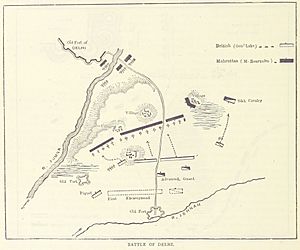Battle of Delhi (1803) facts for kids
Quick facts for kids Battle of Delhi |
|||||||
|---|---|---|---|---|---|---|---|
| Part of the Second Anglo-Maratha War | |||||||
 Map of the Battle of Delhi (1803) |
|||||||
|
|||||||
| Belligerents | |||||||
| Commanders and leaders | |||||||
| Gerard Lake | Daulat Rao Scindia Louis Bourquin |
||||||
| Strength | |||||||
| 4,500 | 17,000 | ||||||
| Casualties and losses | |||||||
| estimated 464 - 485 men killed or wounded. | estimated 3,000 killed or wounded | ||||||
The Battle of Delhi was an important fight that happened on September 11, 1803. It was part of the Second Anglo-Maratha War. This battle was fought near Delhi in India.
On one side were the troops of the British East India Company. They were led by General Lake. On the other side was the Maratha army. Their leaders were General Louis Bourquin and Sardar Ravsaheb Wable. The Marathas were a powerful group in India at that time.
What Happened During the Battle?
General Bourquin had previously worked with another general, Perron. But he had left Perron's side and was now in charge of a large part of the Maratha army. This army had about 17,000 soldiers. The British East India Company had about 4,500 soldiers.
The battle took place near the Yamuna River. This river was behind the Maratha army. This position usually gives an army a strong defense.
General Lake, the British commander, used a clever trick. He pretended that his army was running away. This made the Maratha soldiers leave their strong defensive spot. They chased after the British.
Suddenly, General Lake's troops turned around. They attacked the Marathas with their bayonets. A bayonet is a knife attached to the end of a rifle. The Marathas were pushed back towards the river. Many Maratha soldiers were lost during this attack.
The Outcome of the Battle
The British East India Company won the Battle of Delhi. Three days after the battle, the city of Delhi came under British control. This was a big change. Before this, the Marathas had controlled Delhi.
Later, a monument was built to remember the soldiers who died in the battle. It is located in a place called Patparganj. This monument helps us remember the history of this important event.

